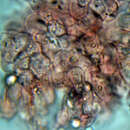pms
nòm ant ël fil


Amanita eliae is an inedible[1] species of fungi in the family of Amanitaceae found in Europe. It was described by Lucien Quélet in 1872.[2] Synonyms include Amanitaria eliae, Amanita godeyi, and Amanita cordae.
Its cap is 8 to 10 centimetres (3.1 to 3.9 in)[3] or 10 to 15 centimetres (3.9 to 5.9 in) in diameter[4] and 6 to 10 centimetres (2.4 to 3.9 in) across. It has a white volva.[1] Its warts correspond to easily removable, deep depressions in the cap of the species.[3] Its stem is around 8 to 12 centimetres (3.1 to 4.7 in) tall and has a diameter of 0.8 to 1.2 centimetres (0.31 to 0.47 in);[1] it is subcylindric and tapers upwards. The cap and stem have white flesh.[1][5] The stem is initially entirely white, but browns with age with a narrow bulb.[6] The stem ring is white.[1] Its stem is smooth and has white gills on the hymenium.[4] Its odour and taste are indistinct.[1][4]
It is commonly found coniferous and deciduous trees.[3] It is found in the autumn and summer.[4]
Amanita eliae is an inedible species of fungi in the family of Amanitaceae found in Europe. It was described by Lucien Quélet in 1872. Synonyms include Amanitaria eliae, Amanita godeyi, and Amanita cordae.